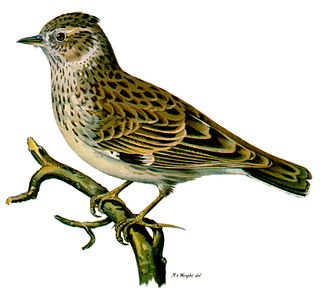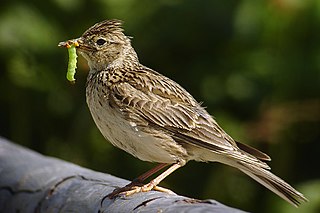
Lullula is the genus of woodlarks, songbirds in the family Alaudidae. There is only one remaining extant species, the woodlark which is found in Europe, the mountains of northern Africa, the Middle East and western Asia. The remainder are known only from the fossil record.

Alauda is a genus of larks found across much of Europe, Asia and in the mountains of north Africa, and one of the species endemic to the islet of Raso in the Cape Verde Islands. Further, at least two additional species are known from the fossil record. The current genus name is from Latin alauda, "lark". Pliny the Elder thought the word was originally of Celtic origin.

Melanocorypha is a small genus of birds in the lark family. The current genus name, Melanocorypha is from Ancient Greek melas, "black", and koruphos a term used by ancient writer for a now unknown bird, but here confused with korudos, "lark".
Carduelis lambrechti is an extinct species of Carduelis that inhabited Hungary during the Neogene period.
Saxicola baranensis is an extinct species of Saxicola that inhabited Hungary during the Neogene period.
Turdus minor is an extinct species of Turdus that inhabited Hungary during the Neogene period.
Calandrella gali is an extinct species of Calandrella that inhabited Hungary during the Neogene period.
Erithacus minor is an extinct species of Erithacus that inhabited Hungary during the Neogene period.
Luscinia pliocaenica is an extinct species of Luscinia that inhabited Hungary during the Neogene period.
Lanius intermedius is an extinct species of Lanius that inhabited Hungary during the Neogene period.
Lullula minuscula is an extinct species of Lullula that inhabited Hungary during the Neogene period.
Lullula minor is an extinct species of Lullula that inhabited Hungary during the Neogene period.
Monticola pongraczi is an extinct species of Monticola that inhabited Hungary during the Neogene period.
Motacilla minor is an extinct species of Motacilla that inhabited Hungary during the Neogene period.
Riparia minor is an extinct species of Riparia that inhabited Hungary during the Neogene period.
Phylloscopus pliocaenicus is an extinct species of Phylloscopus that inhabited Hungary during the Neogene period.
Emberiza pannonica is an extinct species of Emberiza that inhabited Hungary during the Neogene period.
Cinclus minor is an extinct species of Cinclus that inhabited Hungary during the Neogene period.
Cettia janossyi is an extinct species of Cettia that inhabited Hungary during the Neogene period.
Acrocephalus minor is an extinct species of Acrocephalus that inhabited Hungary during the Neogene period.


